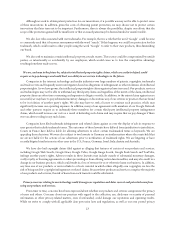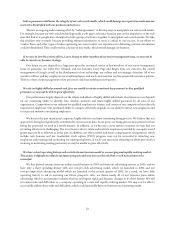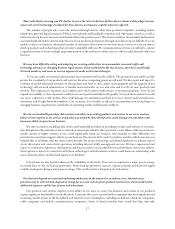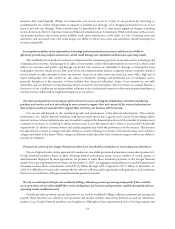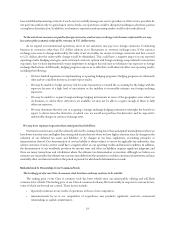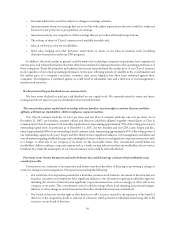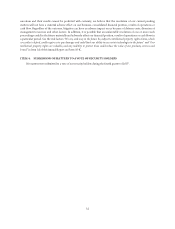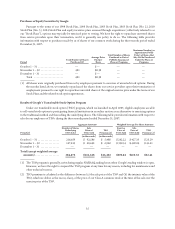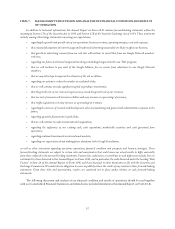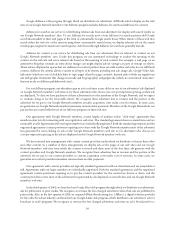Google 2007 Annual Report Download - page 44
Download and view the complete annual report
Please find page 44 of the 2007 Google annual report below. You can navigate through the pages in the report by either clicking on the pages listed below, or by using the keyword search tool below to find specific information within the annual report.• Recommendations by securities analysts or changes in earnings estimates.
• Announcements about our earnings that are not in line with analyst expectations, the risk of which is enhanced
because it is our policy not to give guidance on earnings.
• Announcements by our competitors of their earnings that are not in line with analyst expectations.
• The volume of shares of Class A common stock available for public sale.
• Sales of stock by us or by our stockholders.
• Short sales, hedging and other derivative transactions on shares of our Class A common stock (including
derivative transactions under our TSO program).
In addition, the stock market in general, and the market for technology companies in particular, have experienced
extreme price and volume fluctuations that have often been unrelated or disproportionate to the operating performance of
those companies. These broad market and industry factors may seriously harm the market price of our Class A common
stock, regardless of our actual operating performance. In the past, following periods of volatility in the overall market and
the market price of a company’s securities, securities class action litigation has often been instituted against these
companies. This litigation, if instituted against us, could result in substantial costs and a diversion of our management’s
attention and resources.
We do not intend to pay dividends on our common stock.
We have never declared or paid any cash dividend on our capital stock. We currently intend to retain any future
earnings and do not expect to pay any dividends in the foreseeable future.
The concentration of our capital stock ownership with our founders, executive officers and our directors and their
affiliates will limit our stockholders’ ability to influence corporate matters.
Our Class B common stock has 10 votes per share and our Class A common stock has one vote per share. As of
December 31, 2007, our founders, executive officers and directors (and their affiliates) together owned shares of Class A
common stock, Class B common stock and other equity interests representing approximately 70% of the voting power of our
outstanding capital stock. In particular, as of December 31, 2007, our two founders and our CEO, Larry, Sergey and Eric,
owned approximately 88% of our outstanding Class B common stock, representing approximately 67% of the voting power of
our outstanding capital stock. Larry, Sergey and Eric therefore have significant influence over management and affairs and
over all matters requiring stockholder approval, including the election of directors and significant corporate transactions, such
as a merger or other sale of our company or its assets, for the foreseeable future. This concentrated control limits our
stockholders’ ability to influence corporate matters and, as a result, we may take actions that our stockholders do not view as
beneficial. As a result, the market price of our Class A common stock could be adversely affected.
Provisions in our charter documents and under Delaware law could discourage a takeover that stockholders may
consider favorable.
Provisions in our certificate of incorporation and bylaws may have the effect of delaying or preventing a change of
control or changes in our management. These provisions include the following:
• Our certificate of incorporation provides for a dual class common stock structure. As a result of this structure our
founders, executives and employees have significant influence over all matters requiring stockholder approval,
including the election of directors and significant corporate transactions, such as a merger or other sale of our
company or its assets. This concentrated control could discourage others from initiating any potential merger,
takeover or other change of control transaction that other stockholders may view as beneficial.
• Our board of directors has the right to elect directors to fill a vacancy created by the expansion of the board of
directors or the resignation, death or removal of a director, which prevents stockholders from being able to fill
vacancies on our board of directors.
30





